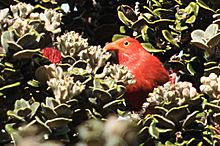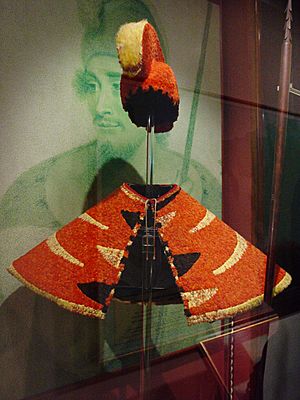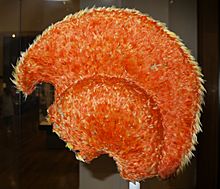Mahiole facts for kids
Quick facts for kids Hawaiian feather helmet |
|
|---|---|
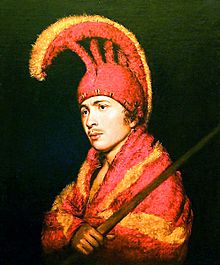
Man Wearing Feather Cloak and Helmit (sic) attributed to Rembrandt Peale.
|
|
| Material | Feathers and plant fibres |
| Created | 18th century |
| Present location | various museums including the British Museum, London |
Hawaiian feather helmets, called mahiole in the Hawaiian language, were special helmets worn by important Hawaiian chiefs. These helmets were worn with beautiful feather cloaks (ʻahu ʻula). Both the helmets and cloaks showed that the person wearing them was a high-ranking chief, part of the aliʻi class.
You can find examples of these traditional helmets in museums all over the world. When Captain Cook visited Hawaii, at least sixteen of these helmets were collected. Mahiole are made from a woven frame decorated with bird feathers. They are amazing examples of featherwork, which is the art of using feathers to create objects. One mahiole was even shown in a painting of Captain Cook's death by Johann Zoffany.
Contents
What Mahiole Look Like
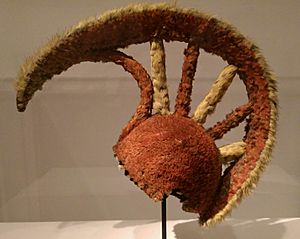
Hawaiians did not usually wear hats. However, during battles, the Aliʻi chiefs wore special woven helmets. These helmets look a bit like old Greek helmets. They also look similar to headwear worn by Buddhist musicians in Ladakh.
Mahiole helmets have a basket-like frame that covers the head. A tall crest runs from the forehead to the back of the neck. The designs of mahiole can be very different. The colors and patterns of the feathers change from one helmet to another. The crest can also be different heights and thicknesses. Many museums have examples of these helmets, showing their different designs.
How Mahiole Were Made
The helmets are built on a strong, light frame made from woven plant fibers. This frame is then covered with feathers, usually from local birds. Sometimes, human hair was used instead of feathers. The plant used for the basket frame is called Freycinetia arborea. This plant is often used for making baskets. Another plant, Touchardia latifolia, a type of nettle, was used to make strong string or thread. This thread was used to tie the feathers onto the basket frame.
Different bird feathers gave the helmets their colors. Black and yellow feathers came from a bird called the Moho or ʻOʻo. There were four types of this bird, but the last one died out in 1987. Black feathers also came from the Mamo bird, which is also now extinct. The bright red feathers came from the 'I'iwi and the ʻApapane birds. These red birds are still common in Hawaii today.
Bird catchers were very skilled. They would catch birds, carefully take a few feathers, and then let the birds go. This way, the birds were not harmed, and their populations were not greatly affected. Each mahiole needed tens of thousands of feathers. Small bundles of feathers were tied together, and then these bundles were tied very close to each other onto the helmet frame. This created a smooth, colorful surface.
Captain Cook's Mahiole
When Captain James Cook visited Hawaii in 1778, he met a high chief named Kalaniʻōpuʻu. At the end of their meeting, Chief Kalaniʻōpuʻu gave Cook the feathered helmet and cloak he was wearing. He also gave Cook other cloaks, pigs, and food. Many items from Cook's travels, including this helmet and cloak, ended up in the collection of Sir Ashton Lever. He showed them in his museum, first called the Holophusikon and later the Leverian Museum.
In the 1790s, the artist Johann Zoffany borrowed Cook's mahiole and cloak from this museum. He included them in his famous painting, The Death of Cook. Sir Ashton Lever later lost his money, and his collection was sold off. The mahiole and cloak were bought by different collectors over the years. In 1912, they were given to New Zealand. Today, you can see them at the Museum of New Zealand Te Papa Tongarewa.
Mahiole in Museums
Bernice P. Bishop Museum, Honolulu
The Bernice P. Bishop Museum in Honolulu has a 200-year-old mahiole and a matching cloak. This bright red and yellow mahiole was given to the king of Kauaʻi, Kaumualiʻi. This happened in 1810 when he agreed to join his island with Kamehameha I's rule. This act united all the islands into the Kingdom of Hawaii.
British Museum, London
The British Museum in London has seven of these Hawaiian helmets. The large red helmet shown in the picture came from the collection of Sir Joseph Banks. Sir Joseph Banks was a wealthy person who loved studying plants. He sailed with Captain Cook on his first journey. He stayed in touch with Cook and his later trips. People think this helmet might have belonged to Charles Clerke, who was Captain Cook's second-in-command. Clerke's collections went to Joseph Banks after Clerke died on Cook's third voyage.
Another helmet at the British Museum has a different design. It has yellow and black circles on a red background. An artist named John Webber, who was Captain Cook's official artist, drew a helmet with this design. The British Museum also has a helmet without feathers. This shows how the frame was built before the feathers were added.
Museum of Ethnology, Vienna
The Museum of Ethnology in Vienna, Austria, got some of its oldest items from the Leverian Museum sale in 1806. Baron Leopold von Fichtel bought many items for his museum in Vienna.
Museum of New Zealand Te Papa Tongarewa, Wellington
The Museum of New Zealand Te Papa Tongarewa has four mahiole helmets. Two were given as gifts by Lord St Oswald in 1912. The New Zealand Government bought the other two in 1948 from William Ockelford Oldman, who collected old cultural items. The British Museum, The Smithsonian, and the Museum of New Zealand Te Papa Tongarewa believe that one of these helmets and its matching cloak were the ones given to Captain Cook by the Hawaiian chief Kalani’ōpu’u. This helmet and cloak look like the ones in Zoffany's painting.
Featured in Media
The feathered helmet from the British Museum was chosen for the radio series A History of the World in 100 Objects. This series started in 2010 and was made by the BBC and the British Museum together.
Cook's mahiole and cloak were also shown in the short TV series Tales from Te Papa. This series was filmed in 2009 and was made by TVNZ and Te Papa.
See also
 In Spanish: Mahiole para niños
In Spanish: Mahiole para niños


